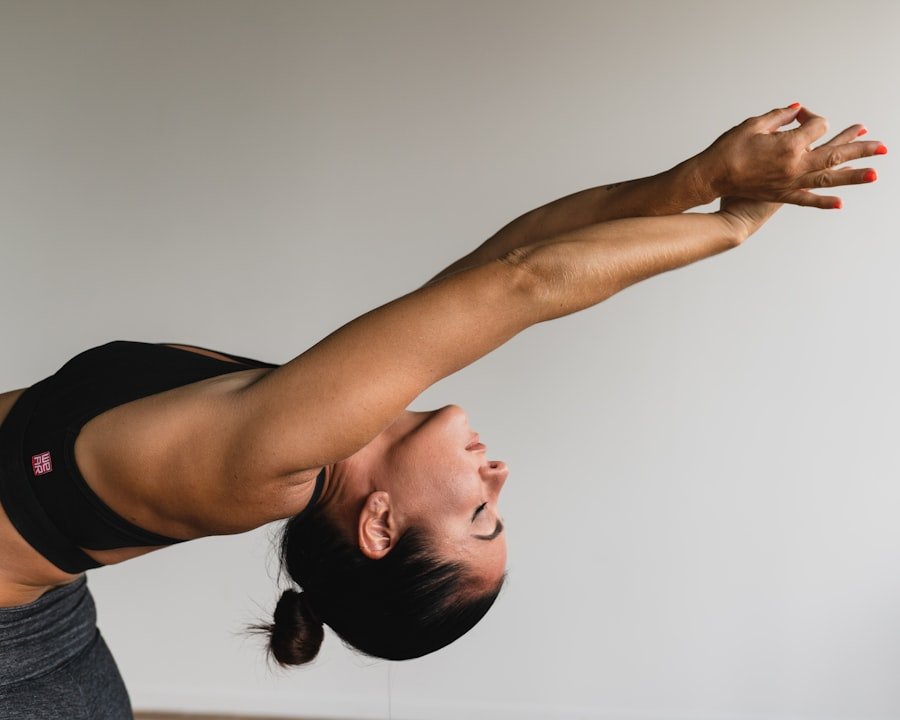Yoga is an ancient practice that has transcended time and culture, becoming a cornerstone for many seeking relief from the pressures of modern life. At its core, yoga is not merely a physical exercise; it is a holistic approach that integrates the mind, body, and spirit. One of the most significant benefits of yoga is its ability to alleviate stress.
Stress manifests in various forms, from anxiety and tension to physical ailments such as headaches and digestive issues. Engaging in regular yoga practice can help mitigate these symptoms by promoting relaxation and enhancing overall well-being. The physiological effects of yoga on stress are profound.
When individuals practice yoga, they engage in a series of postures and breathing exercises that activate the parasympathetic nervous system, often referred to as the “rest and digest” system. This activation leads to a decrease in heart rate and blood pressure, fostering a state of calmness. Furthermore, yoga encourages mindfulness, allowing practitioners to focus on the present moment rather than ruminating on past events or worrying about future challenges.
This shift in focus can significantly reduce feelings of anxiety and promote a sense of peace.
Best Yoga Poses for Relaxation and Stress Reduction
Certain yoga poses are particularly effective for relaxation and stress reduction, each offering unique benefits that cater to different aspects of stress relief. One such pose is Child’s Pose (Balasana), which encourages deep breathing and gentle stretching of the back and hips. This restorative position allows practitioners to surrender their weight to the ground, fostering a sense of safety and comfort.
By focusing on the breath while in this pose, individuals can cultivate a deeper connection to their bodies and release pent-up tension. Another beneficial pose is Legs-Up-the-Wall (Viparita Karani). This restorative posture promotes circulation and helps alleviate feelings of fatigue and anxiety.
By lying on one’s back with legs elevated against a wall, practitioners can experience a gentle inversion that calms the nervous system. The pose encourages relaxation by allowing gravity to assist in draining excess blood from the legs, which can be particularly soothing after a long day of standing or sitting. Incorporating these poses into a regular practice can create a sanctuary for the mind and body, providing essential moments of respite from daily stressors.
Incorporating Breathing Techniques for Maximum Stress Relief

Breath is an integral component of yoga that plays a crucial role in stress management. The practice of pranayama, or breath control, involves various techniques designed to enhance the flow of prana (life force energy) within the body. One effective technique is diaphragmatic breathing, which encourages deep inhalations that expand the diaphragm rather than shallow chest breathing.
This method not only increases oxygen intake but also activates the relaxation response in the body, reducing stress levels significantly. Another powerful breathing technique is Nadi Shodhana, or alternate nostril breathing. This practice involves inhaling through one nostril while closing the other, then switching sides for the exhalation.
Nadi Shodhana balances the left and right hemispheres of the brain, promoting mental clarity and emotional stability. By incorporating these breathing techniques into a yoga routine, practitioners can enhance their ability to manage stress effectively. The rhythmic nature of breath work serves as an anchor during challenging moments, allowing individuals to regain composure and focus.
Creating a Calming Environment for Your Yoga Practice
| Aspect | Metric |
|---|---|
| Lighting | Natural light or soft, warm artificial light |
| Color Scheme | Soft, calming colors such as pastels or earth tones |
| Temperature | Comfortable and consistent temperature |
| Sound | Quiet or soothing background music |
| Aromatherapy | Use of essential oils or incense for a calming scent |
The environment in which one practices yoga can significantly influence the overall experience and effectiveness of stress relief. A calming space should be free from distractions and clutter, allowing for a sense of tranquility to permeate the atmosphere. Soft lighting, such as candles or dimmable lamps, can create an inviting ambiance that encourages relaxation.
Additionally, incorporating elements of nature—such as plants or natural materials—can enhance the connection to the earth and promote a sense of grounding. Sound also plays a vital role in establishing a calming environment. Soft instrumental music or nature sounds can help set the tone for a peaceful practice.
Some individuals may find that using essential oils or incense enhances their experience by engaging their sense of smell. Scents like lavender or chamomile are known for their calming properties and can further aid in reducing stress levels. By thoughtfully curating a serene environment, practitioners can create a sanctuary that supports their journey toward relaxation and stress relief.
The Importance of Consistency in Your Yoga Routine for Stress Relief
While occasional yoga sessions can provide temporary relief from stress, consistency is key to reaping the long-term benefits of this practice. Establishing a regular routine allows individuals to cultivate resilience against stressors over time. Just as physical fitness requires ongoing effort to maintain strength and flexibility, mental well-being benefits from consistent engagement with yoga.
Regular practice fosters familiarity with poses and breathing techniques, making it easier to access these tools during times of heightened stress. Moreover, consistency in yoga practice helps reinforce positive habits that contribute to overall well-being. As individuals commit to their routines, they often find themselves more attuned to their bodies and emotions.
This heightened awareness enables them to recognize early signs of stress and respond proactively rather than reactively. By integrating yoga into daily life—whether through morning sessions or evening wind-downs—individuals can create a sustainable approach to managing stress that becomes an integral part of their lifestyle.
Combining Meditation and Yoga for Ultimate Stress Relief

The synergy between meditation and yoga creates a powerful combination for achieving ultimate stress relief. While yoga focuses on physical postures and breath work, meditation emphasizes mental stillness and introspection. When practiced together, these disciplines enhance one another’s benefits, leading to deeper relaxation and heightened awareness.
Many yoga classes incorporate meditation techniques at the beginning or end of sessions, allowing practitioners to center themselves before moving into physical postures or reflect on their experience afterward. Mindfulness meditation is particularly effective when combined with yoga practice. This technique encourages individuals to observe their thoughts without judgment while remaining present in their bodies.
By integrating mindfulness into yoga sessions, practitioners can cultivate a deeper connection between mind and body, fostering an environment conducive to stress relief. The combination allows individuals to release tension not only physically but also mentally, creating a holistic approach to managing stress that addresses both immediate symptoms and underlying causes.
Different types of stress require tailored approaches within yoga practice to address specific needs effectively. For work-related stress, routines that focus on opening the shoulders and chest can be particularly beneficial. Poses such as Cat-Cow (Marjaryasana-Bitilasana) and Eagle Pose (Garudasana) help release tension accumulated from long hours at a desk or stressful meetings.
Incorporating gentle twists can also aid in detoxifying the body while promoting mental clarity. On the other hand, personal stress stemming from relationships or life changes may benefit from restorative practices that emphasize grounding and self-compassion. Poses like Supported Bridge Pose (Setu Bandhasana) or Savasana (Corpse Pose) allow individuals to connect with their inner selves while fostering acceptance and relaxation.
Additionally, incorporating affirmations or journaling after practice can help process emotions related to personal challenges, creating space for healing and growth.
Tips for Incorporating Yoga into Your Daily Routine for Long-Term Stress Relief
Incorporating yoga into daily life doesn’t have to be an overwhelming commitment; small adjustments can lead to significant changes over time. One effective strategy is to set aside just ten minutes each day for a brief yoga session focused on relaxation techniques or gentle stretches. This manageable approach makes it easier to establish consistency without feeling burdened by lengthy commitments.
Another tip is to integrate yoga into existing routines—such as practicing mindful breathing during breaks at work or engaging in gentle stretches while watching television at home. Utilizing online resources or mobile apps can provide guided sessions tailored to specific needs or time constraints, making it easier to stay motivated and engaged with practice. By weaving yoga into daily life in these small yet meaningful ways, individuals can cultivate resilience against stressors while enhancing their overall well-being over time.
FAQs
What are the best yoga routines for stress relief?
Some of the best yoga routines for stress relief include gentle yoga, restorative yoga, and yin yoga. These practices focus on deep breathing, gentle stretching, and relaxation to help reduce stress and promote a sense of calm.
How often should I practice yoga for stress relief?
For stress relief, it is recommended to practice yoga at least 2-3 times per week. Consistency is key, so establishing a regular yoga routine can help manage stress levels effectively.
Can yoga help reduce stress and anxiety?
Yes, yoga has been shown to be effective in reducing stress and anxiety. The combination of physical postures, breathing techniques, and meditation in yoga can help calm the mind and relax the body, leading to a reduction in stress and anxiety levels.
Are there specific yoga poses that are particularly effective for stress relief?
Certain yoga poses, such as child’s pose, forward folds, and gentle twists, are known for their stress-relieving benefits. These poses help release tension in the body, promote relaxation, and encourage deep breathing, which can all contribute to stress relief.
Is it necessary to have prior experience with yoga to practice for stress relief?
No prior experience with yoga is necessary to practice for stress relief. Beginners can start with gentle yoga routines and gradually build up their practice as they become more comfortable with the poses and techniques. It’s important to listen to your body and practice at your own pace.



